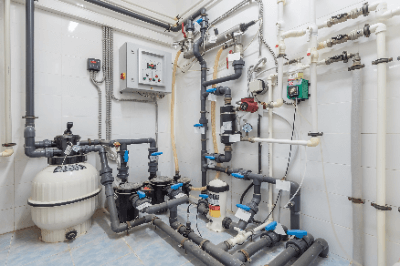Was ist ein Nadelventil?
Nadelventile sind Ventiltypen mit einem Schaft (Ventilschaft), der ein dünnes, spitzes Ende hat.
Nadelventile werden verwendet, um den Durchfluss in einem Durchflussweg zu steuern.
Sie zeichnen sich durch ihre Fähigkeit aus, die Durchflussmenge genau zu regeln, sowie durch ihre Funktion als Absperrventil zum vollständigen Öffnen und Schließen des Durchflussweges. Sie sind jedoch im Allgemeinen für relativ niedrige Durchflussmengen vorgesehen.
Anwendungen von Nadelventilen
Nadelventile werden aufgrund ihrer überragenden Fähigkeit, Durchflussmengen zu regulieren, häufig in Stromregelventilen eingesetzt, wo eine präzise Durchflusseinstellung erforderlich ist. Daher werden sie nur selten in der vollständig geöffneten Stellung verwendet, sondern meist durch Einstellen der Ventilöffnung und Fixierung auf den gewünschten Durchfluss.
Sie werden häufig zur Durchflussregelung in besonders kleinen Bereichen oder bei engen Durchflussregelbereichen eingesetzt. Normale Durchgangsventile (und einige Kugelventile) können den Durchfluss ebenfalls regeln, sind aber weniger präzise und die Feineinstellung ist schwierig, so dass sie im Allgemeinen für Durchflussregelungen verwendet werden, bei denen keine Präzision erforderlich ist.
Nadelventile hingegen können aufgrund ihrer speziell für die Durchflussregelung konzipierten Innenkonstruktion eine präzise und feine Durchflussregelung ermöglichen. Sie werden beispielsweise in der Halbleiterindustrie eingesetzt, um das Volumen der Stickstoffspülung zu regulieren, den Luftstrom zum Öffnen und Schließen von Luftzylinderventilen und Membranventilen zu steuern und als Absperrventile für Manometerflüssigkeiten.
Funktionsweise von Nadelventilen
Der Aufbau eines Nadelventils besteht aus einem Gehäuse (Ventilkasten), einer Spindel (Ventilschaft) und einem Griff.
Das Hauptmerkmal von Nadelventilen ist, dass der Ventilkegel, wie der Name schon sagt, nadelförmig ist. Durchgangsventile ähnlicher Bauart haben einen sehr großen Ventilkegel und eignen sich hervorragend zum Schließen, aber nicht zur Durchflussregelung.
Bei Nadelventilen hebt sich der Ventilkegel (Nadel) am Ende der Spindel, wenn der Griff zum Öffnen des Ventils gedreht wird, und die Kanalöffnung zur Sitzseite ändert sich allmählich. Die Durchflussmenge ändert sich daher nur geringfügig, so dass die Durchflussmenge leicht und präzise eingestellt werden kann.
Nadelventile können als Absperrventile verwendet werden. Nadelventile sind jedoch nicht für einfache Absperrungen geeignet, da die Ventilspindel mehrmals gedreht werden muss, um sie vollständig zu öffnen und zu schließen.
Um die Flüssigkeit vollständig und einfach abzusperren, wird ein Absperrventil, z. B. ein Durchgangsventil oder ein Kugelventil, in den Durchflussstrom eingebaut.
Arten von Nadelventilen
Nadelventile gibt es in den folgenden Ausführungen:
- Typ Öffnen/Schließen
Manuell oder automatisch (elektrisch betätigt oder magnetisch gesteuert) - Art des Rohranschlusses
Mit Gewinde (konische Rohrgewinde Rc, NPT, usw.), Flansch, Ringverbindung, usw.
Automatische Nadelventile werden dort eingesetzt, wo das Öffnen, Schließen und Einstellen des Durchflusses durch Fernsteuerung erforderlich ist. Ein elektrischer Antrieb oder ähnliches wird verwendet, um den Kegel und die Spindel zum Öffnen und Schließen des Ventils zu drehen.
Einige Typen verwenden einen Schrittmotor als Antriebsmotor, der eine genaue und feine Steuerung ermöglicht. Schrittmotoren sind Motoren, die den Drehwinkel mit Hilfe von Impulssignalen steuern können und eine Art von Motoren sind, die eine hohe Positioniergenauigkeit gewährleisten.
Weitere Informationen über Nadelventile
Werkstoffe für Nadelventile
Typische Werkstoffe (Gehäuseteile), die für Nadelventile verwendet werden, sind:
- Messing
- Rostfreier Stahl
Messingwerkstoffe eignen sich für allgemeine Anwendungen und werden häufig für Anwendungen mit niedrigem Druck, ohne Druck, mit geringem Durchfluss wie Luft, Kalt- und Warmwasser, Öl usw. verwendet. Werkstoffe aus rostfreiem Stahl werden z. B. für Gasleitungen für Silan und Stickstofftrifluorid verwendet, die häufig in der Halbleiterindustrie eingesetzt werden.


